
Year 718 (DCCXVIII) was a common year starting on Saturday of the Julian calendar. The denomination 718 for this year has been used since the early medieval period, when the Anno Domini calendar era became the prevalent method in Europe for naming years.

Saint Clotilde (c.474–545), also known as Clothilde, Clotilda, Clotild, Rotilde etc., was the second wife of the Frankish king Clovis I, and a princess of the kingdom of Burgundy, supposedly descended from the Gothic king Aþana-reiks. After their marriage in 492, Clotilde and her husband founded the Merovingian dynasty which ruled for over 200 years. Venerated as a saint by the Roman Catholic Church as well as by the Eastern Orthodox, she was instrumental in her husband's famous conversion to Catholicism and, in her later years, was known for her almsgiving and penitential works of mercy. She is credited with spreading Christianity to the western world.
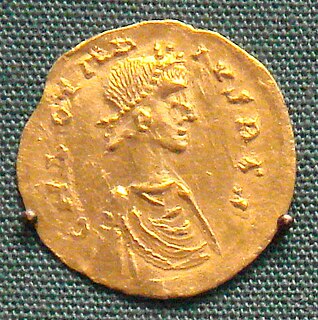
Chlothar II, called the Great or the Young, was King of Neustria and King of the Franks, and the son of Chilperic I and his third wife, Fredegund. He started his reign as an infant under the regency of his mother, who was in an uneasy alliance with Clothar's uncle Guntram, King of Burgundy. Clothar assumed full power over Neustria upon the death of his mother, in 597; though rich this was one of the smallest portions of Francia. He continued his mother's feud with Queen Brunhilda of Austrasia with equal viciousness and bloodshed, finally achieving her execution in an especially brutal manner in 613, after winning the battle that enabled Chlothar to unite Francia under his rule. Like his father, he built up his territories by moving in after the deaths of other kings.
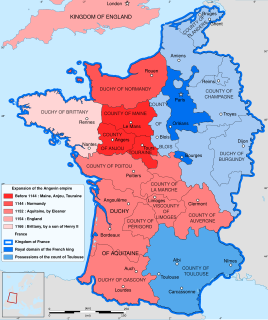
The Duke of Aquitaine was the ruler of the ancient region of Aquitaine under the supremacy of Frankish, English, and later French kings.
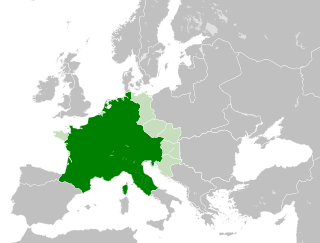
Francia, also called the Kingdom of the Franks, or Frankish Empire was the largest post-Roman barbarian kingdom in Western Europe. It was ruled by the Franks during Late Antiquity and the Early Middle Ages. It is the predecessor of the modern states of France and Germany. After the Treaty of Verdun in 843, West Francia became the predecessor of France, and East Francia became that of Germany. Francia was among the last surviving Germanic kingdoms from the Migration Period era before its partition in 843.
Fredegund or Fredegunda was the Queen consort of Chilperic I, the Merovingian Frankish king of Soissons. She served as regent during the minority of her son Chlothar II from 584 until 597.
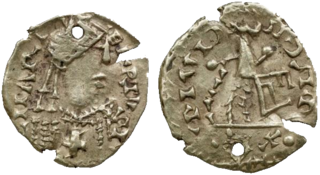
Charibert I was the Merovingian King of Paris, the second-eldest son of Chlothar I and his first wife Ingund. His elder brother Gunthar died sometime before their father's death. He shared in the partition of the Frankish kingdom that followed his father’s death in 561, receiving the old kingdom of Childebert I, with its capital at Paris.
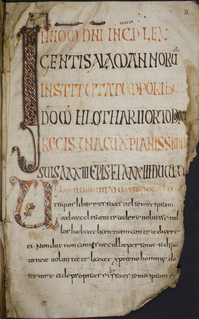
Chlothar IV was the king of Austrasia from 717 until his death. He was a member of the Merovingian dynasty, and was installed by Charles Martel, a candidate for the office of mayor of the palace, in opposition to Chilperic II, whose realm was thus reduced to Neustria. This marks the first time since 679 that the kingdom of the Franks was divided. Following Chlothar's death, it was reunited under Chilperic.
The title Duke [and Prince] of the Franks has been used for three different offices, always with "duke" implying military command and "prince", on those occasions when it was used either with or in preference to "duke", implying something approaching sovereign or regalian rights. The term "Franks" may refer to an ethnic group or the inhabitants of a territory called "Francia", named after the original Franks. The first office was that of the mayors of the palace of the Merovingian kings of the Franks, whose powers increased as those of the kings declined. The second was that of the second-in-command to the early kings of France, the last incumbent of which succeeded to the throne in 987. This title was sometimes rendered Duke of France. The third instance was that of the rulers of the Frankish-inhabited lands of Germany, the so-called "tribal" duchy of Franconia.
Saint Prætextatus, also spelled Praetextatus, Pretextat(us), and known as Saint Prix, was the bishop of Rouen from 549 until his assassination in 586. He appears as a prominent character in Gregory of Tours’ Historia Francorum. This is the principal source from which information on his life can be drawn. He features in many of its most notable passages, including those pertaining to his trial in Paris and his rivalry with the Merovingian Queen Fredegund. The events of his life, as portrayed by Gregory of Tours, have been important in the development of modern understandings of various facets of Merovingian society, such as law, the rivalry between kings and bishops, church councils, and the power of queens.
The Battle of Soissons of 718 was the last of the great pitched battles of the civil war between the heirs of Pepin of Heristal. Since Pepin's death in December 714, his grandson and heir Theudoald, his widow Plectrude, his bastard son Charles Martel, his successor as mayor of the palace in Neustria Ragenfrid, and the new king Chilperic II had been waging a war for ascendancy. Though Ragenfrid and Chilperic had begun with successes and Plectrude and Theudoald were removed early, Martel turned the tide of war and eventually forced the surrender of all his opponents.
Chilperic I was the King of Burgundy from 473 until his death. He succeeded his brother Gundioch and co-ruled with his nephews Godomar, Gundobad, Chilperic II, and Godegisel.
Bodegisel or Bodygisil was a Frankish duke (dux). He was the son of Mummolin, duke of Soissons, and served the kings Chilperic I and Childebert II. According to Hans-Walter Herrmann and Ulrich Nonn, confusion between Bodegisel and a later duke named Bobo is responsible for the semi-legendary duke Boggis who appears in sources from the ninth century on. Bobo was a member of an illustrious Austrasian family and a nephew of the deacon Adalgisel Grimo, but where his dukedom was located is unknown.
Austrovald, Astrobald, and Austrevald was the Duke of Aquitaine from 587.
Maurontus, Maurente, or Maurontius was the Duke or Patrician of Provence in the early 8th century. He aspired to independence in the face of Charles Martel, Duke of the Franks, and the Provençal patrician Abbo.
Mummolus, Mommolus, or Mummulus, was a Gallo-Roman patrician and prefect who served Guntram, King of Burgundy, as a general in the 6th century.
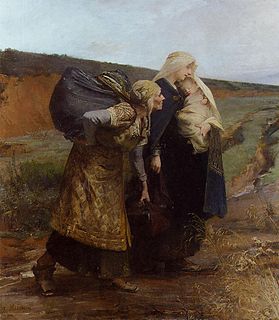
Audovera was the first wife or mistress of Chilperic I, king of Neustria.













